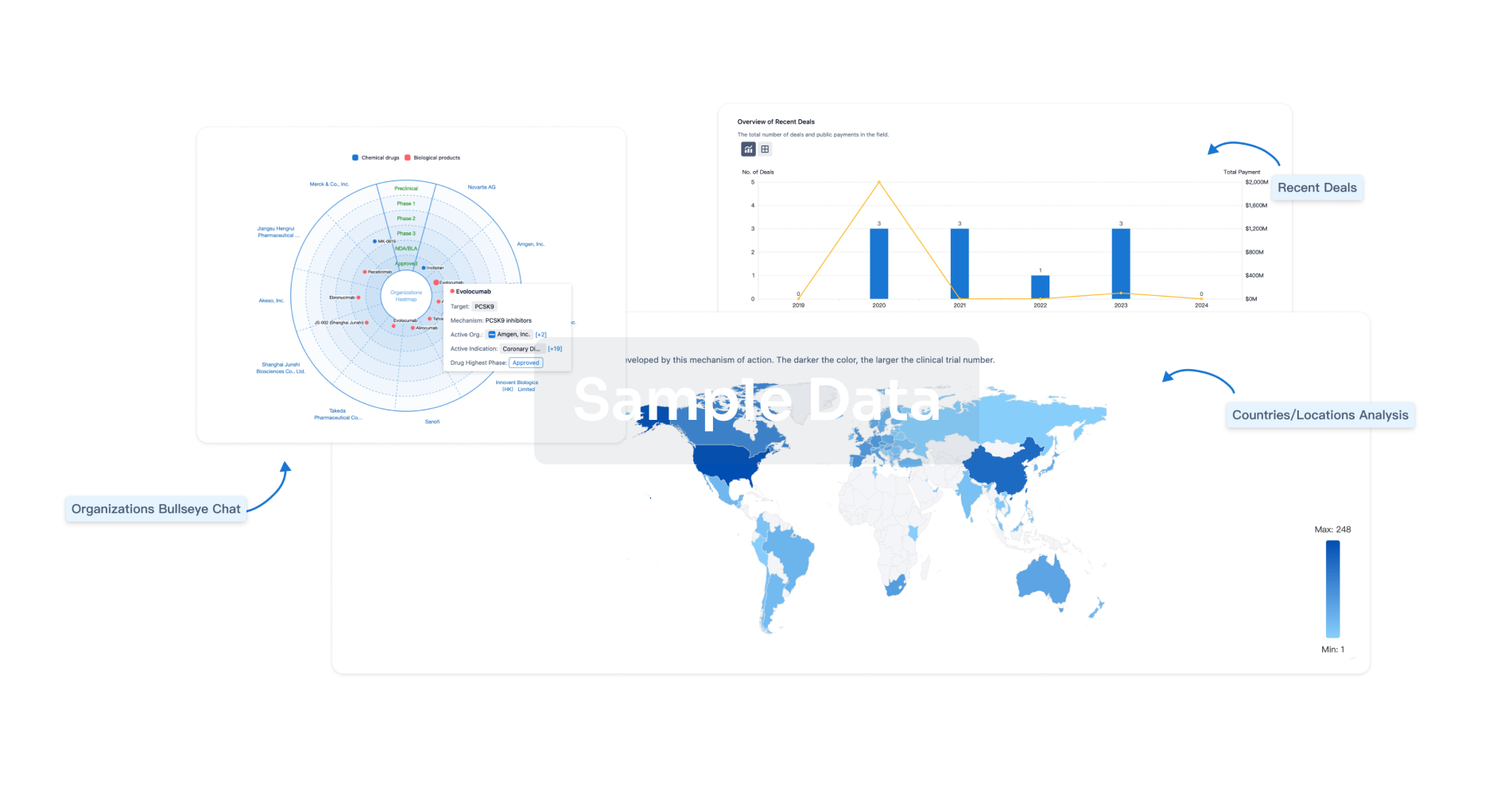Request Demo
Last update 08 May 2025
SLC63 Sphingosine phosphate transporters
Last update 08 May 2025
Basic Info
Synonyms SLC63 Sphingosine phosphate transporters, Solute carrier family 63, Sphingolipid transporter family + [2] |
Introduction- |
Related
4
Drugs associated with SLC63 Sphingosine phosphate transportersTarget |
Mechanism SPNS2 inhibitors |
Originator Org. |
Active Indication |
Inactive Indication- |
Drug Highest PhasePreclinical |
First Approval Ctry. / Loc.- |
First Approval Date20 Jan 1800 |
Target |
Mechanism SPNS2 inhibitors |
Active Org. |
Originator Org. |
Active Indication |
Inactive Indication- |
Drug Highest PhasePreclinical |
First Approval Ctry. / Loc.- |
First Approval Date20 Jan 1800 |
Target |
Mechanism SPNS2 inhibitors |
Originator Org. |
Active Indication |
Inactive Indication- |
Drug Highest PhasePreclinical |
First Approval Ctry. / Loc.- |
First Approval Date20 Jan 1800 |
100 Clinical Results associated with SLC63 Sphingosine phosphate transporters
Login to view more data
100 Translational Medicine associated with SLC63 Sphingosine phosphate transporters
Login to view more data
0 Patents (Medical) associated with SLC63 Sphingosine phosphate transporters
Login to view more data
185
Literatures (Medical) associated with SLC63 Sphingosine phosphate transporters01 May 2025·British Journal of Pharmacology
Assessment of Spinster homologue 2 (Spns2)‐dependent transport of sphingosine‐1‐phosphate as a therapeutic target
Article
Author: Lynch, Kevin R. ; Souza, George M. P. R. ; Dunnavant, Kyle ; Nimchuk, Katherine E. ; Juskiewicz, Zuzanna J. ; Isakson, Brant E. ; Merchak, Andrea R. ; Xu, Wehao ; Alexander, Simon S. ; Shin, Jung‐Bum ; Foster, Daniel ; Kharel, Yugesh ; Gaultier, Alban ; Huang, Tao ; Santos, Webster L. ; Leitinger, Norbert ; Abbott, Stephen B. G. ; Pavelec, Caitlin M.
01 May 2025·Biomolecules & Therapeutics
Stress Accelerates Depressive-Like Behavior through Increase of SPNS2 Expression in Tg2576 Mice
Article
Author: Park, Jung Ho ; Yun, Jaesuk ; Hong, Jin Tae ; Chang, Ju Young ; Kim, Yuri ; Son, Dong Ju ; Ham, Hyeon Joo ; Yoo, Seung Sik ; Lee, Dong Won ; Yeo, In Jun ; Han, Sang-Bae
03 Mar 2025·Journal of Clinical Investigation
Endothelial OX40 activation facilitates tumor cell escape from T cell surveillance through S1P/YAP-mediated angiogenesis
Article
Author: Wang, Mingyi ; Wei, Yingying ; Liu, Jilan ; Zhang, Junfeng ; Xiong, Huabao ; Bie, Qingli ; Wang, Sen ; Zhang, Baogui ; Zhang, Xu ; He, Baoyu ; Zhang, Yanhua ; Zhao, Mingsheng ; Liang, Jing ; Zhang, Xiao ; Dong, Guanjun ; Huang, Lunhua ; Dong, Fengyun ; Yang, Dong ; Zhao, Rou ; Zhang, Bin ; Pan, Hongli
2
News (Medical) associated with SLC63 Sphingosine phosphate transporters10 Aug 2023
New research has successfully reversed hearing loss in mice. Scientists used a genetic approach to fix deafness in mice, restoring their hearing abilities in low and middle frequency ranges.
New research from The Institute of Psychiatry, Psychology & Neuroscience (IoPPN) at King's College London has successfully reversed hearing loss in mice.
The research, published in Proceedings of the National Academy of Sciences, used a genetic approach to fix deafness in mice with a defective Spns2 gene, restoring their hearing abilities in low and middle frequency ranges. Researchers say this proof-of-concept study suggests that hearing impairment resulting from reduced gene activity may be reversible.
Over half of adults in their 70s experience significant hearing loss. Impaired hearing is associated with an increased likelihood of experiencing depression and cognitive decline, as well as being a major predictor of dementia. While hearing aids and cochlear implants may be useful, they do not restore normal hearing function, and neither do they halt disease progression in the ear. There is a significant unmet need for medical approaches that slow down or reverse hearing loss.
Researchers in this study bred mice with an inactive Spns2 gene. Mice were then provided with a special enzyme at differing ages to activate the gene after which their hearing improved. This was found to be most effective when Spns2 was activated at a young age, with the positive effects of gene activation becoming less potent the longer the researchers waited to provide the intervention.
Professor Karen Steel, Professor of Sensory Function at King's IoPPN and the study's senior author said, "Degenerative diseases such as progressive hearing loss are often believed to be irreversible, but we have shown that at least one type of inner ear dysfunction can be reversed. We used a genetic method to show this reversal as a proof-of-concept in mice, but the positive results should encourage research into methods like gene therapy or drugs to reactivate hearing in people with a similar type of hearing loss."
Dr Elisa Martelletti, the study's first author from King's IoPPN said, "Seeing the once-deaf mice respond to sounds after treatment was truly thrilling. It was a pivotal moment, demonstrating the tangible potential to reverse hearing loss caused by defective genes. This groundbreaking proof-of-concept study unlocks new possibilities for future research, sparking hope for the development of treatments for hearing loss."
This study was possible thanks to funding from the Medical Research Council, Wellcome, and from Decibel Therapeutics Inc.
19 Aug 2022
In the past few years, three new drugs for CKD have emerged on the market: J&J’s Invokana, AstraZeneca’s Farxiga — both SGLT2 inhibitors — and more recently, Bayer’s Kerendia, a mineralocorticoid receptor antagonist. Notably, Farxiga was approved on the back of a trial that reduced the risk of death for CKD patients — a first for any CKD drug.
However, these new drugs have yet to stop or reverse the disease itself, leaving researchers still searching for better, safer options.
In a study published in
Science Translational Medicine
, scientists from Mark Okusa’s lab at the University of Virginia look at a new target on a previously tried-and-failed pathway, showing that going after the new target reduced kidney injury and scar tissue buildup in mouse models.
Novartis previously tried its multiple sclerosis drug Gilenya for CKD, in hopes it could reduce inflammation and fibrosis associated with the disease, only to see it flunk a Phase III study. Gilenya is an S1P receptor agonist that reduces inflammation by slowing white blood cells from leaving the lymph nodes. Looking at the same pathway, Okusa’s lab previously showed that deleting a gene that codes for a protein needed to make S1P in mice protected them from kidney tissue scarring.
In this study, Okusa’s lab followed up on that finding. They observed that when S1P, a signaling molecule implicated in cell migration among other processes, was transported out of kidney cells through a transporter dubbed Spns2, there were increased amounts of inflammatory cytokines, immune cell activity, and fibrosis in both cell and mouse models.
So the researchers created an Spns2 inhibitor to prevent that S1P transport out of the kidney cells. In cells, that inhibitor successfully reduced inflammatory cytokines, and in mice, it reduced the degree of kidney fibrosis. In another mouse experiment, the researchers compared their inhibitor to Gilenya and found that, unlike Gilenya, their inhibitor protected against kidney fibrosis.
“Targeting this S1P signaling pathway, enabling control of S1P concentrations in the local microenvironment, is a promising strategy for the treatment of kidney fibrosis and potentially other inflammatory and fibrotic diseases that can perhaps avoid the adverse events associated with systemic modulation of S1P receptors,” the researchers wrote in the study.
Analysis
Perform a panoramic analysis of this field.
login
or

AI Agents Built for Biopharma Breakthroughs
Accelerate discovery. Empower decisions. Transform outcomes.
Get started for free today!
Accelerate Strategic R&D decision making with Synapse, PatSnap’s AI-powered Connected Innovation Intelligence Platform Built for Life Sciences Professionals.
Start your data trial now!
Synapse data is also accessible to external entities via APIs or data packages. Empower better decisions with the latest in pharmaceutical intelligence.
Bio
Bio Sequences Search & Analysis
Sign up for free
Chemical
Chemical Structures Search & Analysis
Sign up for free

